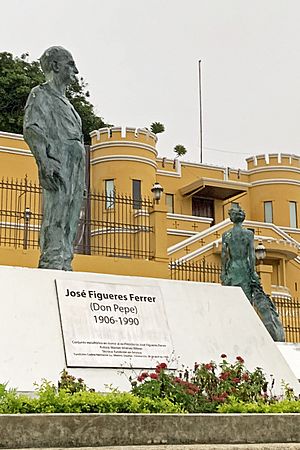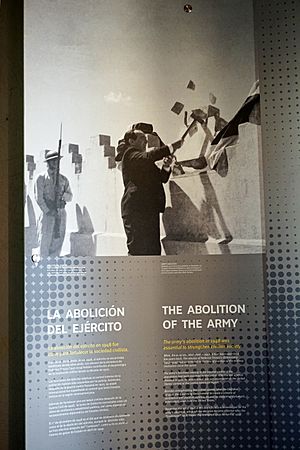José Figueres Ferrer facts for kids
Quick facts for kids
José Figueres Ferrer
|
|
|---|---|

Figueres in 1973
|
|
| President of Costa Rica | |
| In office 8 May 1970 – 8 May 1974 |
|
| Vice President | Manuel Aguilar Bonilla Jorge Rossi Chavarría |
| Preceded by | José Joaquín Trejos Fernández |
| Succeeded by | Daniel Oduber Quirós |
| In office 8 November 1953 – 8 May 1958 |
|
| Vice President | Raúl Blanco Cervantes Fernando Esquivel Bonilla |
| Preceded by | Otilio Ulate Blanco |
| Succeeded by | Mario Echandi Jiménez |
| In office 8 May 1948 – 8 November 1949 |
|
| Preceded by | Teodoro Picado Michalski |
| Succeeded by | Otilio Ulate Blanco |
| Personal details | |
| Born |
José María Hipólito Figueres Ferrer
25 September 1906 San Ramón, Alajuela, Costa Rica |
| Died | 8 June 1990 (aged 83) San José, San José, Costa Rica |
| Political party | PLN |
| Spouses | Henrietta Boggs Karen Olsen Beck |
| Alma mater | Massachusetts Institute of Technology |
| Profession | Landowner, politician |
| Signature |  |
José María Hipólito Figueres Ferrer (born September 25, 1906 – died June 8, 1990) was a very important leader in Costa Rica. People often called him "Don Pepe." He served as the President of Costa Rica three times. These terms were from 1948–1949, 1953–1958, and 1970–1974.
During his first time as president, he made big changes. He got rid of the country's army. He also made banks owned by the government. Women and Afro-Costa Ricans gained the right to vote. People of African descent could also become Costa Rican citizens.
His son, José María Figueres, also became president later. He served from 1994 to 1998.
Contents
Early Life and Beginnings
Figueres was born on September 25, 1906. His hometown was San Ramón in the Alajuela province. He was the oldest of four children. His parents were a doctor and a teacher from Catalonia. They had recently moved to Costa Rica.
In 1924, he traveled to Boston, United States. He went there to work and study. He learned about hydroelectric engineering at the Massachusetts Institute of Technology. Figueres came back to Costa Rica in 1928. He bought a farm in Tarrazú and called it "The Endless Struggle."
He became a very successful farmer. He grew coffee and made ropes. More than 1,000 people worked for him. He built homes and offered medical care for his workers. He also started a community garden and gave free milk to workers' children.
Becoming a Political Leader
Starting His Political Journey (1944–1948)
Figueres returned to Costa Rica in 1944. He had been living away for two years. He had criticized the president, Rafael Ángel Calderón Guardia. When he came back, he started the Democratic Party. This party later became the Social Democratic Party.
He wanted his party to stand against the ruling National Republican Party. This party was led by former President Calderón. Many people were upset with Calderón. They accused him of corruption. Figueres and his party used this to gain support.
Figueres began training a group called the Caribbean Legion. This group had about 700 members. Figueres and others started a revolution. They wanted to remove the government. They hoped to use Costa Rica as a base. Then, they planned to remove other dictators in Central America.
Figueres carried out some attacks in Costa Rica. These happened in 1945 and 1946. He hoped for a big strike, but people did not join.
The Costa Rican Civil War
In 1948, there was a problem with the presidential election. Supporters of former President Calderón said the results were fake. They said Otilio Ulate had won unfairly. Protests over the election grew into a war.
In March and April 1948, armed conflict began. Figueres fought against Communist-led groups and the Costa Rican Army. The war lasted 44 days. More than 2,000 people died. It was the bloodiest event in Costa Rica's 20th century.
Figueres as Provisional President (1948–1949)

After the civil war, Figueres became president. He led a temporary government for 18 months. This group was called the Founding Council. During this time, he made many important changes:
- He abolished the army. This was to prevent military leaders from taking power. Figueres said he was inspired by a book he read. He believed the future of humanity should not include armies. Costa Rica has not had an army since then. It has a police force instead.
- He allowed women and people who couldn't read to vote.
- He started basic welfare programs to help people.
- He nationalized banks, meaning the government owned them.
- He outlawed the Communist Party.
- He guided the writing of a new constitution.
- He made sure everyone had access to public education.
- He gave citizenship to children of black immigrants.
- He created a civil service system. This helped stop favoritism in government jobs.
Figueres said his changes completely changed the country. He believed it was a deeper revolution than the one in Cuba. He admired what President Franklin D. Roosevelt did in the United States.
After 18 months, Figueres stepped down. He gave power to Otilio Ulate. Since then, Costa Ricans have solved their problems using their constitution.
Second Term as President (1953–1958)
In 1953, Figueres started the Partido Liberación Nacional (PLN) party. This became a very successful political party in Costa Rica. He was elected president again in 1953. Many people see him as the most important political figure in Costa Rica's history.
During his time as president, he continued to make changes. He kept the banking system nationalized. He also helped build the Pan-American Highway. This road goes across Central America. He supported local businesses and industries. He helped create a strong middle class in the country.
Figueres sometimes disagreed with the United States. He criticized their support for dictators in other countries. He even boycotted a meeting in 1954. This meeting was held in a country ruled by a military dictator.
Border War with Nicaragua (1954–1955)
Figueres's support for the Caribbean Legion caused problems. In 1954, anti-Somoza exiles tried to invade Nicaragua. This led to Nicaragua's leader, Anastasio Somoza García, attacking Costa Rica. Former Costa Rican president Rafael Calderón also invaded Costa Rica in January 1955.
Because Figueres had abolished the army, Costa Rica had no military. He asked the Organization of American States (OAS) for help. The OAS ordered a cease-fire. They sent a group to investigate the situation.
Somoza then used planes to bomb Costa Rican towns. Figueres told the OAS that Costa Rica could not defend itself. The OAS allowed the United States to sell fighter planes to Costa Rica for a very low price. This help from the United States ended the invasion. Somoza's forces left Costa Rica.
Third Presidential Term (1970–1974)
The economy of Costa Rica faced challenges in the early 1970s. Figueres found a new market for coffee. He sold 30,000 tons of coffee to the Soviet Union in 1972. Costa Rica then became the only Central American country to have official relations with Moscow. The World Bank and International Monetary Fund also provided money to help the economy.
In 1971, some people tried to hijack a plane in San José. Figueres himself stood on the runway. He aimed a gun at the plane until the hijackers gave up. He was known for being brave and direct.
Important Connections
Working with the CIA
The CIA gave Figueres money for a political magazine called Combate. They also helped fund a training school in Costa Rica. This school was for democratic political parties in Latin America. The CIA kept its role a secret from most people.
Figueres said in 1981 that he did get help from the CIA. He said he was friends with Allen Dulles, who led the CIA. He said the CIA helped him with a magazine and youth conferences. He also said he asked them not to do the Bay of Pigs Invasion in Cuba.
Figueres and a CIA agent formed a group called INADESMO. This group helped send money more easily. For example, INADESMO helped fund a conference in Peru.
In 1961, Figueres hosted a meeting at his farm. Leaders of Dominican exile groups met there. They agreed to form a government if dictator Rafael Trujillo was overthrown. Trujillo was later assassinated. The CIA had been in contact with people who wanted to remove Trujillo.
Relationship with Cuba
Figueres also did not like the dictator in Cuba before Fidel Castro. He even sent weapons to Cuban rebels led by Castro. But after the 1959 Cuban Revolution, Figueres and Castro disagreed. Figueres was worried about the growth of Communist ideas in Cuba.
In 1959, Figueres visited Havana. During a speech, he warned Castro about the changes he saw in Cuba. His microphone was quickly turned off. Figueres supported John F. Kennedy's Alliance for Progress. But he did not support the CIA's secret wars with Cuba.
Robert Vesco, a Fugitive Financier
One of Figueres's most debated decisions was giving safety to Robert Vesco. Vesco was a financier from the U.S. accused of stealing millions of dollars. Vesco had a personal and business relationship with Figueres. He also gave money to political campaigns in Costa Rica.
Figueres said he would send Vesco back to the U.S. if they asked. But he tried to help Vesco with President Jimmy Carter. This caused a big political stir in Costa Rica. Figueres's party lost the 1978 election. Vesco left Costa Rica after the new president, Rodrigo Carazo, promised to expel him.
In 1981, Figueres said Vesco made mistakes. But he added that he would always protect his friends. He said he was sad that some friends thought he personally gained from Vesco.
Life After Presidency
Figueres was well-liked in many Latin American countries. He was known for his ideas about social democracy. Many people consider him a great contributor to this idea.
After being president, Figueres became an important elder statesman. He often acted as a special ambassador for later governments.
He supported the Nicaraguan Revolution in 1979. This revolution overthrew dictator Anastasio Somoza Debayle. He criticized the U.S. for supporting the Contras in Nicaragua.
His supporters suggested he run for president a fourth time in the 1980s. But this idea did not gain enough support.
"This is an amazing little country," Figueres told the Los Angeles Times in 1986. "We are an example for Latin America. In the next century, maybe everyone will be like us."
Family Life
Figueres married Henrietta Boggs from the United States in 1941. They had two children, Muni and José Martí. They divorced in 1954. He then married Karen Olsen Beck, also from the United States. They had four children: José María, Karen Christiana, Mariano, and Kirsten. His second wife was a member of Costa Rica's Legislative Assembly.
He was good friends with Luis Muñoz Marín, the Governor of Puerto Rico.
His son, José María, also became president from 1994 to 1998. His daughter, Muni Figueres Boggs, is the current Ambassador from Costa Rica to the United States. Another daughter, Christiana Figueres, is a diplomat. She was a key person in creating the Paris Agreement on climate change.
Awards and Recognition
 Taiwan: Order of Propitious Clouds (1973)
Taiwan: Order of Propitious Clouds (1973)
See also
 In Spanish: José Figueres Ferrer para niños
In Spanish: José Figueres Ferrer para niños
- Costa Rican Civil War
| Political offices | ||
|---|---|---|
| Preceded by Teodoro Picado |
President of Costa Rica 1948–1949 |
Succeeded by Otilio Ulate |
| Preceded by Otilio Ulate |
President of Costa Rica 1953–1958 |
Succeeded by Mario Echandi |
| Preceded by José Joaquín Trejos |
President of Costa Rica 1970–1974 |
Succeeded by Daniel Oduber |


